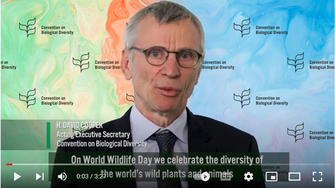
On World Wildlife Day we celebrate the diversity of the world’s wild plants and animals and the contribution they make to our lives and to the health of the planet. Wildlife provides people with food, medicines, shelter and fuel. They help to regulate the climate and provide us with clean water. They are an integral part of the culture and identity of many indigenous peoples and local communities. They are source of inspiration and wonder for us all.
But wildlife is under great threat. Over the past fifty years, the abundance of wild animal species has declined on average by around two-thirds. This is driven by deforestation and other land-use change, by overfishing and unsustainable hunting, by pollution, diseases and invasive species, and now, increasingly, by climate change. Without urgent action to address these drivers, around one million species face a high risk of extinction.
A few months ago, in December 2022, governments came together to adopt the Kunming-Montreal Global Biodiversity Framework – with the aim of halting and reversing biodiversity loss by 2030, and cutting the extinction rate for all species by a factor of ten by 2050.
Specific targets call for action to protect 30 % of the planet, to restore 30% of degraded areas, and to bring the loss of areas of high biodiversity value close to zero. All by 2030.
Further, action must be taken to ensure that the use, harvesting and trade of wild species is sustainable, safe and legal, while respecting and protecting customary sustainable use by indigenous peoples and local communities.
These actions will also reduce the risk of pathogen spill-over and future pandemics.
The Framework also calls for urgent management actions to halt human-induced extinctions of known threatened species by 2030.
Achieving such ambitious goals and targets requires action by everyone. By governments, businesses and by all people. The theme for this year’s World Wildlife Day “Partnerships for Wildlife Conservation” highlights the critical role of working together.
The Convention on Biological Diversity (CBD) works alongside thirteen other conventions and international organizations as part of the Collaborative Partnership on Sustainable Wildlife Management.
This year, World Wildlife Day marks the 50th anniversary of our sister convention CITES, the Convention on International Trade in Endangered Species of Wild Fauna and Flora. Over this time, CITES has successfully regulated trade in animals, plants and the wildlife products derived from them, including food products, exotic leather goods, timber and wood products, souvenirs, cosmetics and medicines. Let us celebrate the and build upon this work.
Let us work together in partnerships for conservation. Let us work together to build a shared future for all Life on Earth.